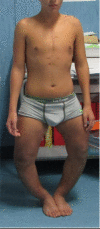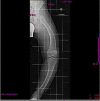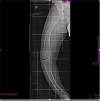A New de novo Mosaic Mutation of PHEX Gene: A Case Report of a Boy with Hypophosphatemic Rickets
- PMID: 36847234
- PMCID: PMC10518859
- DOI: 10.2174/1871530323666230227142202
A New de novo Mosaic Mutation of PHEX Gene: A Case Report of a Boy with Hypophosphatemic Rickets
Abstract
Background: X-linked hypophosphatemia is the most prevalent form of heritable rickets, characterized by an X-linked dominant inheritance pattern. The genetic basis of X-linked hypophosphatemia is a loss-of-function mutation in the PHEX gene (Phosphate regulating gene with Homology to Endopeptidases on the X chromosome), which leads to an enhanced production of phosphaturic hormone FGF23. X-linked hypophosphatemia causes rickets in children and osteomalacia in adults. Clinical manifestations are numerous and variable, including slowdown in growth, swing-through gait and progressive tibial bowing, related to skeletal and extraskeletal actions of FGF23. PHEX gene spans over 220 kb and consists of 22 exons. To date, hereditary and sporadic mutations are known (missense, nonsense, deletions and splice site mutations).
Case presentation: Herein, we describe a male patient carrying a novel de novo mosaic nonsense mutation c.2176G>T (p.Glu726Ter) located in exon 22 of PHEX gene.
Conclusion: We highlight this new mutation among possible causative of X-linked hypophosphatemia and suggest that mosaicism of PHEX mutations is not so uncommon and should be excluded in diagnostic workflow of heritable rickets both in male and female patients.
Keywords: FGF23; X-linked hypophosphatemia; dominant X-linked inheritance; endopeptidase; phosphate regulating gene; vitamin D resistant rickets.
Copyright© Bentham Science Publishers; For any queries, please email at epub@benthamscience.net.
Conflict of interest statement
The authors declare no conflict of interest financial or otherwise.
Figures
References
-
- Filisetti D., Ostermann G., von Bredow M., Strom T., Filler G., Ehrich J., Pannetier S., Garnier J.M., Rowe P., Francis F., Julienne A., Hanauer A., Econs M.J., Oudet C. Non-random distribution of mutations in the PHEX gene, and under-detected missense mutations at non-conserved residues. Eur. J. Hum. Genet. 1999;7(5):615–619. doi: 10.1038/sj.ejhg.5200341. - DOI - PubMed
-
- Francis F., Strom T.M., Hennig S., Böddrich A., Lorenz B., Brandau O., Mohnike K.L., Cagnoli M., Steffens C., Klages S., Borzym K., Pohl T., Oudet C., Econs M.J., Rowe P.S.N., Reinhardt R., Meitinger T., Lehrach H. Genomic organization of the human PEX gene mutated in X-linked dominant hypophosphatemic rickets. Genome Res. 1997;7(6):573–585. doi: 10.1101/gr.7.6.573. - DOI - PubMed
-
- Ishihara Y., Ohata Y., Takeyari S., Kitaoka T., Fujiwara M., Nakano Y., Yamamoto K., Yamada C., Yamamoto K., Michigami T., Mabe H., Yamaguchi T., Matsui K., Tamada I., Namba N., Yamamoto A., Etoh J., Kawaguchi A., Kosugi R., Ozono K., Kubota T. Genotype-phenotype analysis, and assessment of the importance of the zinc-binding site in PHEX in Japanese patients with X-linked hypo-phosphatemic rickets using 3D structure modeling. Bone. 2021;153:116135. doi: 10.1016/j.bone.2021.116135. - DOI - PubMed
Publication types
MeSH terms
Substances
LinkOut - more resources
Full Text Sources
Medical




